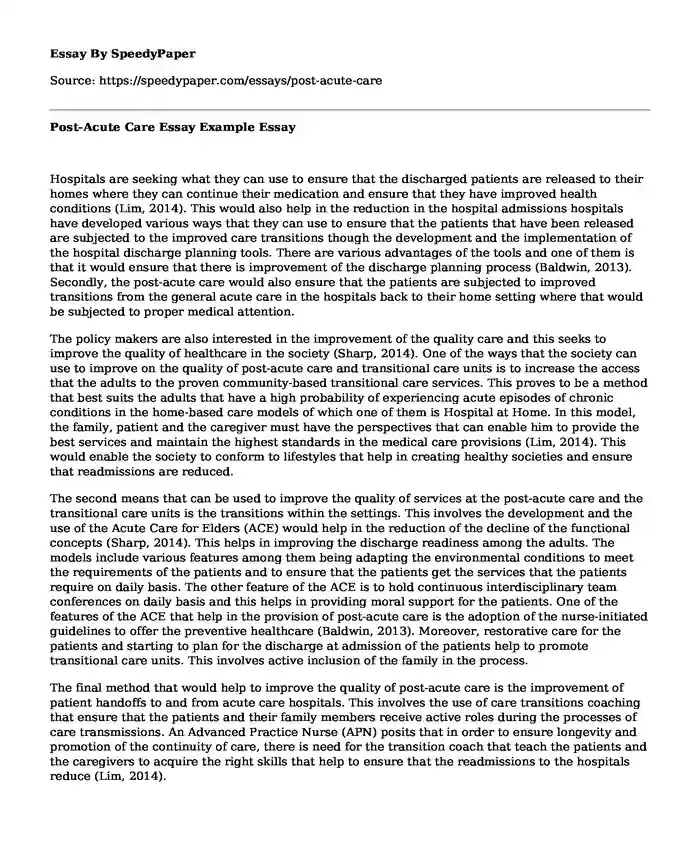
| Type of paper: | Essay |
| Categories: | Health and Social Care |
| Pages: | 3 |
| Wordcount: | 681 words |
Hospitals are seeking what they can use to ensure that the discharged patients are released to their homes where they can continue their medication and ensure that they have improved health conditions (Lim, 2014). This would also help in the reduction in the hospital admissions hospitals have developed various ways that they can use to ensure that the patients that have been released are subjected to the improved care transitions though the development and the implementation of the hospital discharge planning tools. There are various advantages of the tools and one of them is that it would ensure that there is improvement of the discharge planning process (Baldwin, 2013). Secondly, the post-acute care would also ensure that the patients are subjected to improved transitions from the general acute care in the hospitals back to their home setting where that would be subjected to proper medical attention.
The policy makers are also interested in the improvement of the quality care and this seeks to improve the quality of healthcare in the society (Sharp, 2014). One of the ways that the society can use to improve on the quality of post-acute care and transitional care units is to increase the access that the adults to the proven community-based transitional care services. This proves to be a method that best suits the adults that have a high probability of experiencing acute episodes of chronic conditions in the home-based care models of which one of them is Hospital at Home. In this model, the family, patient and the caregiver must have the perspectives that can enable him to provide the best services and maintain the highest standards in the medical care provisions (Lim, 2014). This would enable the society to conform to lifestyles that help in creating healthy societies and ensure that readmissions are reduced.
The second means that can be used to improve the quality of services at the post-acute care and the transitional care units is the transitions within the settings. This involves the development and the use of the Acute Care for Elders (ACE) would help in the reduction of the decline of the functional concepts (Sharp, 2014). This helps in improving the discharge readiness among the adults. The models include various features among them being adapting the environmental conditions to meet the requirements of the patients and to ensure that the patients get the services that the patients require on daily basis. The other feature of the ACE is to hold continuous interdisciplinary team conferences on daily basis and this helps in providing moral support for the patients. One of the features of the ACE that help in the provision of post-acute care is the adoption of the nurse-initiated guidelines to offer the preventive healthcare (Baldwin, 2013). Moreover, restorative care for the patients and starting to plan for the discharge at admission of the patients help to promote transitional care units. This involves active inclusion of the family in the process.
The final method that would help to improve the quality of post-acute care is the improvement of patient handoffs to and from acute care hospitals. This involves the use of care transitions coaching that ensure that the patients and their family members receive active roles during the processes of care transmissions. An Advanced Practice Nurse (APN) posits that in order to ensure longevity and promotion of the continuity of care, there is need for the transition coach that teach the patients and the caregivers to acquire the right skills that help to ensure that the readmissions to the hospitals reduce (Lim, 2014).
References
Baldwin, M. R., Wunsch, H., Reyfman, P. A., Narain, W. R., Blinderman, C. D., Schluger, N. W., ... & Bach, P. (2013). High Burden of Palliative Needs among Older Intensive Care Unit Survivors Transferred to PostAcute Care Facilities. A Single-Center Study. Annals of the American Thoracic Society, 10(5), 458-465.
Lim, K. (2014). Post-acute care. Geriatric Medicine: An Introduction, 349.
Sharp, S., Linkewich, E., Willems, J., Tahair, N., Levy, C., & Bayley, M. (2014). Abstract T P259: What Should Really be Happening to Our Stroke Patients Post-Acute Care?: A System Best Practice Model for Inpatient Rehab. Stroke, 45(Suppl 1), ATP259-ATP259.
Cite this page
Post-Acute Care Essay Example. (2019, May 31). Retrieved from https://speedypaper.net/essays/post-acute-care
Request Removal
If you are the original author of this essay and no longer wish to have it published on the SpeedyPaper website, please click below to request its removal:
- Gothic Architecture Characteristics
- Essay Example on Book Critique: Action Speaks by Paul Green
- Essay Example in IT Project Management
- Law Essay Example: Bill C-31 and Bands
- Free Essay Example - Management Psychology and HRM
- Free Essay: Mental Health a Major Concern Among the Youth Today
- Paper Example: Reading and Understanding the Content
Popular categories




